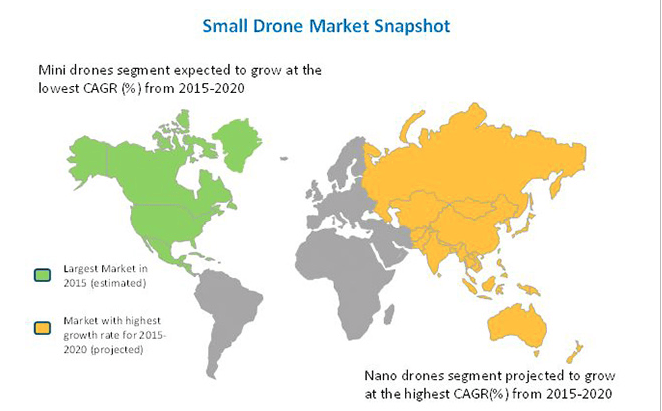
A new report by Markets and Markets predicts that the the global market in small drones will grow from 5.80 Billion in 2015 to 10.04 Billion by 2020, at a compound annual growth rate (CAGR) of 11.6%. The report says that commercial applications will be responsible for most of the growth.
Factors such as rising demand for operational efficiency for surveillance and reconnaissance, and minimized human intervention in combat and other risky military operations and in commercial avenues, such as agriculture and transportation for crop monitoring and packet delivery respectively, are the major factors that will drive the global small drones market.
Segmenting the market into mini, micro and nano drones, the report predicts that nano drones will be the fastest growing segment, as nano drone technology improves. While as demonstrated in the figure above, the current market is heaviest in the US, the Markets and Markets report sees demand shifting to the other side of the world:
The Asia-Pacific region is expected to exhibit the highest growth rate in the small drones market, and is projected to grow at a highest CAGR during the forecast period from 2015 to 2020. The Asia-Pacific market is expected to grow at the highest CAGR, because several Asia-Pacific countries such as India, China, Australia, South Korea, and others have focused production of small drones for commercial and defense purposes, such as crop monitoring, logistics, reconnaissance and surveillance, among others.
While the development of the small drone market may appear to be shifting overseas, the US small drone market- particularly nano drones – may be assisted in the US by the proposed development of a micro-drone classification as part of new FAA regulations. A micro drone – a drone weighing under 4.4 pounds including payload – does not require a licensed pilot to operate it, and is exempt from other commercial regulations.
In addition, some nano drones may fall under the 9 ounce limit for drone registration in the US, and enjoy a much looser regulation environment. As nano technology develops, their increased use for commercial purposes may allow the US drone industry to make an effective end-run around the FAA’s current onerous commercial regulation framework.
Miriam McNabb is the Editor-in-Chief of DRONELIFE and CEO of JobForDrones, a professional drone services marketplace, and a fascinated observer of the emerging drone industry and the regulatory environment for drones. Miriam has penned over 3,000 articles focused on the commercial drone space and is an international speaker and recognized figure in the industry. Miriam has a degree from the University of Chicago and over 20 years of experience in high tech sales and marketing for new technologies.
For drone industry consulting or writing, Email Miriam.
TWITTER:@spaldingbarker
Subscribe to DroneLife here.